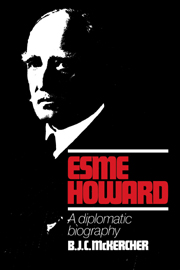Book contents
- Frontmatter
- Contents
- Acknowledgements
- List of abbreviations
- 1 The making of a diplomat, 1863–1903
- 2 Crete: consulship and civil war, 1903–1906
- 3 Washington: Imperial affairs and arbitration, 1906–1908
- 4 Budapest and Berne: prelude to the Great War, 1908–1913
- 5 Stockholm: war and diplomacy in neutral northern Europe, 1913–1916
- 6 Stockholm: diplomacy and war in neutral northern Europe, 1916–1918
- 7 Paris: Poland, the Baltic States, and the Treaty of Versailles, 1918–1919
- 8 Madrid: Anglo-Spanish relations, 1919–1924
- 9 Washington redux: rebuilding good relations, 1924–1927
- 10 Washington redux: meeting the American challenge, 1927-1930
- Epilogue and conclusion ‘A great ambassador’
- Notes
- Bibliography
- Index
9 - Washington redux: rebuilding good relations, 1924–1927
Published online by Cambridge University Press: 06 October 2009
- Frontmatter
- Contents
- Acknowledgements
- List of abbreviations
- 1 The making of a diplomat, 1863–1903
- 2 Crete: consulship and civil war, 1903–1906
- 3 Washington: Imperial affairs and arbitration, 1906–1908
- 4 Budapest and Berne: prelude to the Great War, 1908–1913
- 5 Stockholm: war and diplomacy in neutral northern Europe, 1913–1916
- 6 Stockholm: diplomacy and war in neutral northern Europe, 1916–1918
- 7 Paris: Poland, the Baltic States, and the Treaty of Versailles, 1918–1919
- 8 Madrid: Anglo-Spanish relations, 1919–1924
- 9 Washington redux: rebuilding good relations, 1924–1927
- 10 Washington redux: meeting the American challenge, 1927-1930
- Epilogue and conclusion ‘A great ambassador’
- Notes
- Bibliography
- Index
Summary
If … we act on the assumption that, war between Great Britain and the United States being impossible, we are indifferent as to what action the United States Government may take with reference to their navy, and that we have no intention of competing with America in the matter of naval armaments, I am inclined to think that one of the principal arguments of the Big Navy School here will disappear and that the mass of voters, and consequently Congressmen, will be less willing to spend money on the armaments desired by that School.
Howard, October 1924In the months following Primo's coup, Howard enjoyed the ‘new-found peace’ in Anglo-Spanish relations that conducting business with a stable regime entailed. ‘Life for the moment’, he later recorded, ‘was, therefore, moving on more comfortable lines than it had for the past three and a half years’. Turning 60 in September 1923, he now seemed content to end his diplomatic career in Madrid building on the success he had achieved in the difficult two years after Annual. However, this did not happen, for unexpectedly, on 14 December 1923, Curzon wired his intention to have Howard succeed Sir Auckland Geddes as ambassador in Washington. The foreign secretary's laconic offer was accompanied by a telegram from Tyrrell, now an assistant under-secretary at the Foreign Office, who as ‘an old friend’ urged Howard to ignore any personal misgivings about accepting this transfer in ‘consideration of the best interests of the country and your service’.
- Type
- Chapter
- Information
- Esme HowardA Diplomatic Biography, pp. 269 - 299Publisher: Cambridge University PressPrint publication year: 1989



